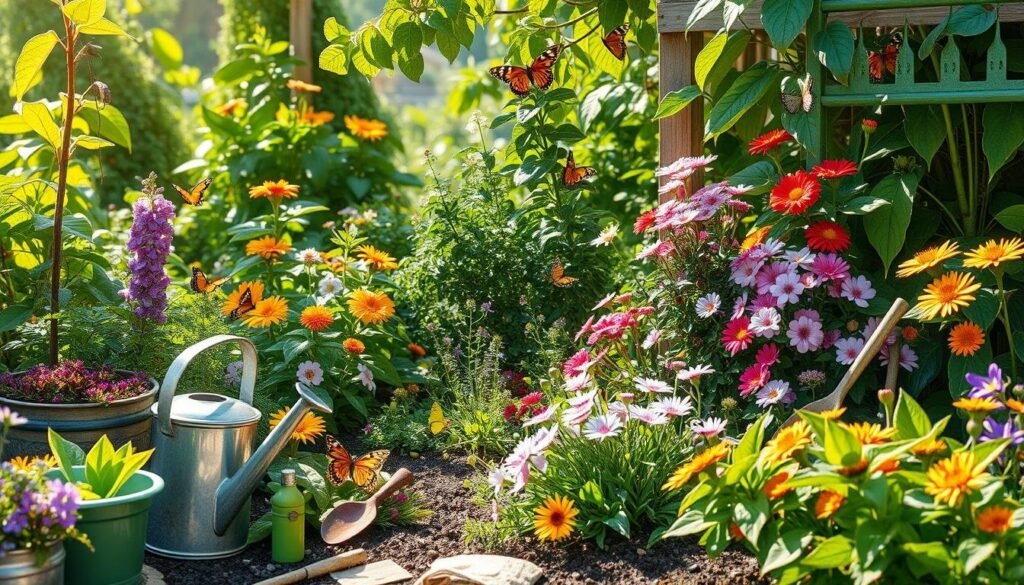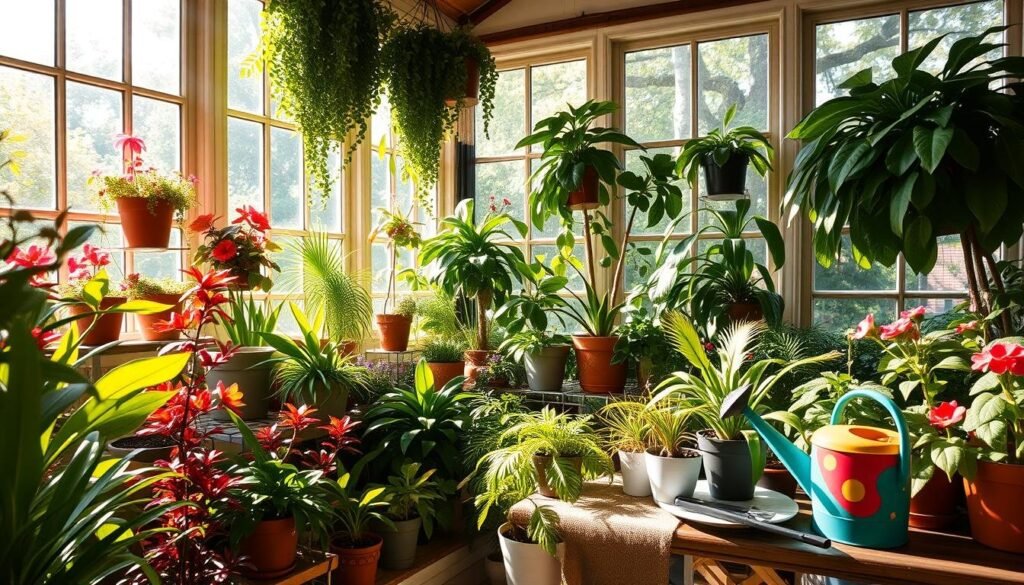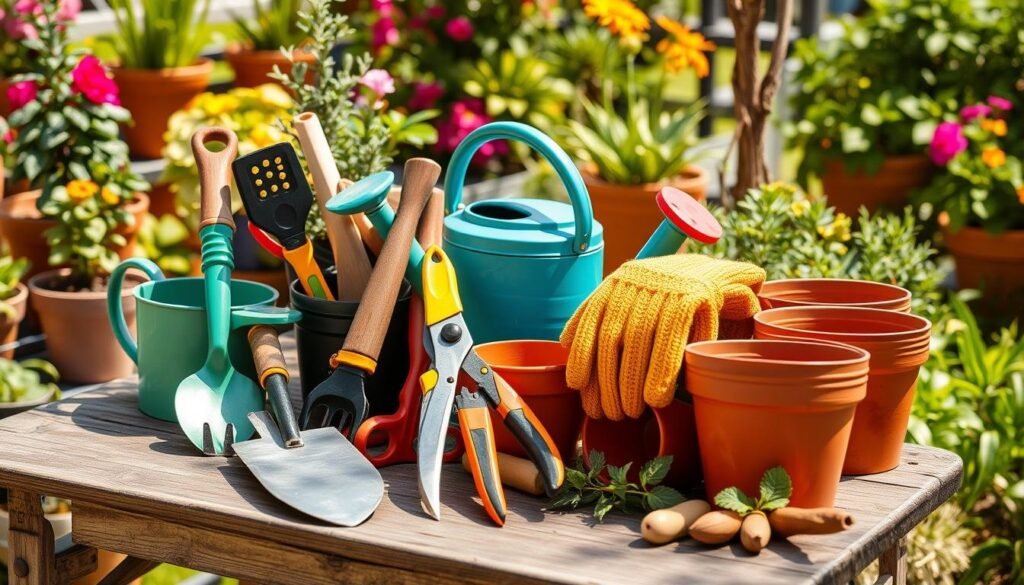Gardening is a rewarding hobby that connects us with nature. It’s easy for anyone to start growing plants, indoors or outdoors. Whether you have a small apartment or a big backyard, gardening is for everyone.
This guide will share simple tips for beginners. You’ll learn how to make any space green and beautiful. Start your gardening journey and enjoy the calm and sense of achievement it brings.
Key Takeaways
- Gardening is an accessible hobby for everyone.
- With beginner-friendly tips, anyone can successfully grow plants.
- Indoor and outdoor gardening offers various benefits.
- Understanding plant care basics enhances growth and health.
- Connecting with nature through gardening can be very rewarding.
Why Gardening is an Awesome Hobby for Beginners
Gardening is more than just planting flowers or vegetables. It’s a great way to express your creativity and relax. Beginners find many benefits, making it a rewarding hobby that matches their interests and goals.
Gardening is good for your mental health. Being in nature, surrounded by plants, can lower stress and improve mindfulness. It’s a calm place for thinking and connecting with the earth.

Joining community gardening clubs adds a social aspect. Beginners meet others who share their passion. This support and camaraderie can boost motivation and learning, making gardening a shared adventure.
The joy of growing plants, whether for food or beauty, is immense. It’s fulfilling to see each seed grow and succeed. For beginners, gardening is a journey of discovery, skill-building, and satisfaction.
Understanding Your Space: Indoor vs. Outdoor Gardening
Choosing where to garden is key for both new and seasoned gardeners. Indoor and outdoor gardening have different effects on plants and the gardener. Knowing these differences helps gardeners decide where to grow their plants.
Benefits of Indoor Gardening
Indoor gardening has many perks for those wanting plants at home. Some main benefits include:
- Air Purification: Indoor plants can clean the air by removing toxins.
- Space-Saving: Using vertical gardening and small pots makes gardening possible in tight spots.
- Controlled Environment: You can control the temperature and humidity, helping plants grow consistently.
- Year-Round Gardening: Indoor gardening lets you grow plants anytime, no matter the weather.
Advantages of Outdoor Gardening
Outdoor gardening also has its own benefits that can make gardening more enjoyable. Some main advantages include:
- Variety of Plant Options: Many plants do better outside, offering more choices.
- Natural Light Access: Outdoor plants get the sunlight they need for photosynthesis.
- Soil Nutrients: Gardeners can use natural soil nutrients for healthier plants.
- Gardening as a Social Activity: Outdoor gardening often brings people together, creating shared experiences.

Essential Gardening Tools for Beginners
Starting a gardening journey needs the right tools for success and fun. Whether you garden indoors or outdoors, some tools make it easier and more rewarding.
Must-Have Tools for Indoor Gardening
For indoor gardening, having the right tools is key. Here are some essentials:
- Potting Soil: A good mix helps plants grow well.
- Watering Can: Pick one with a long spout for easy watering.
- Grow Lights: They ensure plants get enough light, even in dark spots.
- Pruners: Great for cutting off dead leaves and keeping plants healthy.
Basic Tools for Outdoor Gardening
Outdoor gardening needs tools that can handle the weather and make yard work easier. Here are some basics:
- Shovel: Good for digging holes and mixing soil.
- Garden Fork: Perfect for breaking up soil and adding compost.
- Pruners: Essential for trimming plants and shrubs.
- Garden Gloves: Keep your hands safe while gardening.

Choosing the Right Plants for Your Environment
Starting a garden is exciting, but picking the right plants is key. Learning how to choose plants for beginners helps new gardeners feel confident. Things like light and how much care a plant needs are important. Here are some great options for inside and outside your home.
Top Indoor Plants for Beginners
For indoor gardening, some plants are better than others. They are easy to care for and look great:
- Pothos: It has beautiful vines and heart-shaped leaves that do well in different lights.
- Snake Plant: This plant is very hardy and needs little care, making it perfect for beginners.
- Spider Plant: It cleans the air and has lovely arching leaves that add beauty and freshness.
- Peace Lily: It’s elegant and has white flowers that bloom in low light.
Best Outdoor Plants for New Gardeners
For outdoor gardening, picking easy plants is smart. They help your garden grow well with little effort. Here are some great picks:
- Marigold: They are bright and easy to care for, growing well in many soils.
- Lavender: This herb is fragrant and attracts bees and butterflies, and it loves full sun.
- Zinnias: They are hardy and colorful, blooming all summer and attracting butterflies.
- Begonia: Begonias come in many colors and are easy to care for, adding beauty to your garden.
Adding these plants to your garden can make it rewarding and fun for new gardeners.
Gardening Tips: Soil Preparation for Successful Growth
Soil preparation is key for a healthy garden. It affects how well plants grow, how much water they need, and their roots. Different soils, like sandy, clay, and loamy, have their own effects on plants.
- Test the Soil: Knowing the pH level helps decide if you need to add anything for better growing.
- Add Organic Matter: Using compost or aged manure makes the soil richer and better for plants.
- Stir and Aerate: Turning the soil well lets air in, helping good microbes grow.
- Consider Drainage: The soil should drain well to avoid waterlogging and root rot.
- Layering: In raised beds, mixing different materials can make the soil even better.
Learning these soil preparation tips will help beginners create a great place for plants to grow.
Watering Wisely: Plant Care Basics
Watering is key to keeping plants healthy and growing. Knowing what each plant needs can really help. For indoor plants, there are indoor plant care tips to follow. Outdoor gardeners can use outdoor plant watering strategies to keep their plants happy.
Understanding Watering Needs for Indoor Plants
Indoor plants need careful watering. The type of plant, pot size, and environment all matter. Too much water can cause root rot, while too little can make leaves wilt.
Look for signs like yellow leaves or damp soil for too much water. Brown tips or dry soil mean plants need more water. Start by checking your plants every day. Adjust how often you water based on what you see, making sure you’re watering plants correctly.
Outdoor Watering Techniques for Healthy Plants
Outdoor gardeners need good watering methods. Watering in the early morning is best. It lets plants soak up water before it gets hot.
Using outdoor plant watering strategies like drip irrigation helps. It sends water straight to the roots, saving water. Check the soil moisture often to know when to water. This keeps your outdoor plants healthy.
Light Requirements: Optimizing Sunlight for Plants
Plants need the right amount of light to grow well. This is key in gardening. Each plant type needs different light levels and times to thrive.
There are three main types of light for plants:
- Direct sunlight: Great for plants that love the sun. It’s direct and unblocked.
- Indirect sunlight: Softer and bounces off surfaces. Many indoor plants prefer it.
- Low light: Some plants do well in little light. Perfect for dark spots.
When giving plants sunlight, where you put them matters a lot. Indoor gardeners should place pots near windows. This lets them get natural light all day. South-facing windows are best, and west-facing ones have strong afternoon sun.
Outdoor gardeners need to think about where to plant. Watch the sun’s path to pick the best spots. Choose plants that match your garden’s light conditions for better growth.
- Check your home or garden for sunlight patterns.
- Pick plants that like the light you have.
- Use mirrors or white walls to reflect light and help plants.
Knowing what each plant needs for light helps gardeners create a great space. This is true for both indoor and outdoor gardens.
| Light Type | Best For | Characteristics |
|---|---|---|
| Direct Sunlight | Cacti, Succulents | Strong, uninterrupted sunlight; ideal for heat-loving plants. |
| Indirect Sunlight | Pothos, Spider Plant | Filtered light through curtains or spaces away from direct sunlight; promotes healthy growth. |
| Low Light | Snake Plant, ZZ Plant | Minimal light requirements; perfect for low-light indoor environments. |
Fertilization for Healthy Plants: When and How
Fertilization is key to making plants grow well. It’s important to pick the right fertilizers and methods for indoor and outdoor plants. Good fertilization helps plants grow strong and healthy, making gardening rewarding.
Types of Fertilizers for Indoor Plants
For indoor plants, there are many fertilizers to choose from. Here are some common ones:
- Liquid fertilizers: These are absorbed quickly, great for a fast nutrient boost.
- Granular fertilizers: They release nutrients slowly, feeding plants over time.
- Organic fertilizers: Like compost or fish emulsion, they improve soil health and balance.
Fertilizing Techniques for Outdoor Gardens
Outdoor gardening needs special fertilizing methods to feed plants well and protect the environment. Here are some effective ways:
- Side-dressing: Apply fertilizer in bands beside plants to feed the roots directly.
- Foliar feeding: Spray fertilizers on leaves for quick nutrient uptake, especially for micronutrients.
- Incorporating fertilizers into the soil: Mix fertilizers into the soil before planting for easy root access.
Pest Control: Keeping Your Plants Healthy
Keeping your garden healthy is key, indoors and outdoors. Knowing how to spot and deal with pests is crucial. It helps your plants grow well and produce more.
Spotting pests starts with knowing who’s in your indoor garden. This lets you act fast to keep them out.
Identifying Common Indoor Pests
Indoor plants face many pests that harm their health and look. Some common pests are:
- Spider mites: Tiny bugs that make fine webs, often on leaves’ undersides.
- Aphids: Small, soft insects that gather on new growth, sucking plant sap.
- Mealybugs: White, cottony bugs in leaf joints, taking away nutrients.
- Fungus gnats: Small flies around soil and leaves, harming roots with their larvae.
Spotting these pests early helps prevent damage and keeps your plants healthy.
Natural Pest Control Methods for Outdoor Gardens
Using natural ways to fight pests in outdoor gardens is good for the environment. Some methods are:
- Companion planting: Planting some crops together to keep pests away, like marigolds with veggies.
- Beneficial insects: Ladybugs and lacewings help control aphids and mites naturally.
- Neem oil: Made from neem seeds, it keeps many pests away.
- Homemade sprays: Soap and water mix suffocates soft pests when sprayed.
Using these natural methods helps gardeners grow vibrant, pest-free gardens. It makes a healthy space for plants to flourish. By fighting pests, gardeners keep their plants strong and green all year.
Easy Gardening Ideas for Small Spaces
Gardening in small spaces can be a fun challenge. With a little creativity and planning, you can add greenery to even the smallest areas. Vertical gardening and container gardening are great ways to grow plants without needing a lot of ground.
Vertical Gardening Techniques
Vertical gardening makes the most of your space and looks great. You can use trellises, wall racks, or hanging planters for climbing plants and herbs. This method saves space, improves air flow, and lets plants get more sunlight.
- Trellises: Great for beans, peas, or tomatoes, they help plants grow up.
- Wall Planters: Perfect for herbs and flowers, they add beauty and keep the ground free.
- Vertical Towers: These innovative solutions hold many plants in a small space.
Container Gardening Tips for Limited Areas
Container gardening is perfect for small spots like balconies or porches. By picking the right containers, you can grow a variety of plants. Here are some tips for container gardening:
- Choose the Right Size: Pick containers that match the plant’s size when it’s fully grown.
- Drainage: Make sure containers have holes for water to drain.
- Use Quality Soil: Good potting mix helps plants grow well and hold moisture.
Enhancing Your Gardening Skills: Resources & Communities
Starting to garden can be thrilling yet overwhelming. The right resources can make learning easier. Websites like the National Gardening Association and local extension services have lots of helpful content. They cover everything from basics to advanced techniques.
Gardening communities are also key. Joining local clubs or online forums connects you with others. You can share tips, solve problems, and learn from others. Social media groups are great for showing off your garden and getting advice from experts. Being part of these groups makes gardening more fun and educational.
Indoor and Outdoor Gardening Hacks for Success
Gardening is fun and rewarding. Simple hacks for beginners make gardening easier and more efficient. Here are some cool tips for both indoor and outdoor gardeners.
- Kitchen Scrap Composting: Use vegetable scraps like peelings and ends for composting. This enriches the soil while reducing waste.
- DIY Plant Labels: Create plant labels using recycled materials, such as old spoons or popsicle sticks, to easily identify different species.
- Natural Pest Deterrents: Use peppermint or garlic spray as a natural repellent for pests in outdoor gardens.
- Eggshell Fertilizer: Crushed eggshells offer calcium when buried in soil, promoting healthy plant growth.
- Plastic Bottle Watering Stakes: Repurpose a plastic bottle to provide slow, consistent watering for plants, especially useful for busy gardeners.
Using these indoor gardening tips and outdoor gardening tricks saves time and effort. They also promote sustainable gardening practices.
| Gardening Hack | Benefits |
|---|---|
| Kitchen Scrap Composting | Reduces waste and enriches soil |
| DIY Plant Labels | Easy identification of plants |
| Natural Pest Deterrents | Environmentally friendly pest control |
| Eggshell Fertilizer | Provides essential nutrients |
| Plastic Bottle Watering Stakes | Consistent watering for busy schedules |
Conclusion
This gardening guide has come to an end. It’s time to think about all the benefits of gardening. Gardening is a great hobby for connecting with nature and improving your mood. It also lets you grow your own food.
For beginners, this guide has shown how to start gardening. You can garden indoors or outdoors. It’s all about finding what works for you.
Now, it’s time to start gardening. You’ll learn about picking plants and how to care for your garden. Each step helps your garden grow.
Gardening has its ups and downs. But with the right knowledge, you can make your garden a beautiful place. It’s a journey filled with joy and learning.
So, why not start gardening today? You’ll discover the magic of growing your own garden.
FAQ
What are some easy gardening tips for beginners?
Start with easy plants and good soil. Make sure they get enough sunlight. Keep a watering schedule and know what your plants need.
How can I grow plants indoors and outdoors successfully?
For indoors, pick plants like pothos or snake plants that like indirect light. Outdoors, choose plants for your climate. Make sure they get the right sunlight and water. Watch their health closely.
What are some beginner-friendly plant care tips?
Learn to check soil moisture before watering. Use fertilizer right during growing season. Rotate plants for even light. Know each plant’s light and water needs.
What are some easy gardening ideas for small spaces?
Use vertical gardening with wall planters or trellises. Container gardening works well too. It lets you grow many plants in small areas like pots or hanging baskets.
What should I know about pest control for my plants?
Learn to spot pests like spider mites and aphids. Use natural methods like companion planting and beneficial insects. This keeps your garden healthy without chemicals.
When is the best time to fertilize my plants?
Fertilize in spring and summer when plants grow. Use liquid fertilizers for indoor plants every few weeks. Outdoor gardens might need granular fertilizers as needed.
How do I optimize sunlight for my indoor and outdoor plants?
Place indoor plants where they get enough natural light. Consider direct and indirect sunlight. For outdoors, pick spots based on sunlight needs. Make sure they get enough sun all day.
Are there any gardening hacks that can help beginners?
Yes! Use kitchen scraps for compost. Make plant labels from recycled stuff. Use old containers for planting. These save money and are good for the planet.
